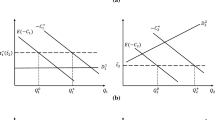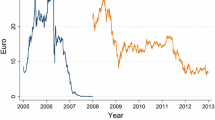Abstract
In the present paper, we analyse the interaction of a competitive market for emission permits with an oligopolistic product market. It is well known that a competitive permits market achieves the cost minimizing distribution of abatement effort among the polluting firms for a given reduction in emissions. However, when the product market is oligopolistic, it may redistribute production inefficiently among firms. It has been suggested that this inefficiency can outweigh the gains obtained from using emission permits instead of command and control. Although this argument is clearly correct under full information, it is shown in the present paper that it reverses under incomplete information. In particular, it is shown that when tradeable emission permits are specified according to the standard textbook example, they yield higher social welfare than the command and control regulation.
Similar content being viewed by others
References
Baumol, W. J. and W. E. Oates (1988),The Theory of Environmental Policy. Cambridge: Cambridge University Press.
Besanko, D. (1987, ‘Performance Versus Design Standards in the Regulation of Pollution’,Journal of Public Economics 34, 19–44.
Borenstein, S. (1988), ‘On the Efficiency of Competitive Markets for Operating Licenses’,Quarterly Journal of Economics 103, 357–387.
Buchanan, J. M. (1969), ‘External Diseconomies, Corrective Taxes, and Market Structure’,American Economic Review 59, 174–177.
Dasgupta, P. (1982),The control of Resources. Cambridge: Harvard University Press.
Hung, M. N. and E. S. Sartzetakis (1994), ‘On Welfare Consequences of Permits Trading Under Imperfect Competition’,Working paper, GREEN, Départment d'économique, Université Laval, Québec.
Malueg, D. A. (1990), ‘Welfare Consequences of Emission Credit Trading Programs’,Journal of Environmental Economics and Management 19, 66–77.
Misiolek, W. S. and H. W. Elder (1987), ‘Exclusionary Manipulation of Markets for Pollution Rights’,Journal of Environmental Economics and Management 16 156–166.
Sartzetakis, E. S. (1993), ‘Cost-Efficiency and Welfare Comparison of Tradeable Emission Permits to Command and Control’,Working paper, Cahier 93-21, GREEN, Département d'économique, Université Laval, Québec.
Torrens, I. M., J. E. Cichanowicz, and J. B. Platt (1992), ‘The 1990 Clean Air Act Amendments: Overview, Utility Industry Responses, and Strategic Implications’,Annu. Rev. Energy Environ. 17, 211–233.
von de Fehr, N.-H. M. (1993), ‘Tradeable Emission Rights and Strategic Interaction’,Environmental and Resource Economics 3, 129–151.
Author information
Authors and Affiliations
Rights and permissions
About this article
Cite this article
Sartzetakis, E.S. Tradeable emission permits regulations in the presence of imperfectly competitive product markets: Welfare implications. Environ Resource Econ 9, 65–81 (1997). https://doi.org/10.1007/BF02441370
Received:
Issue Date:
DOI: https://doi.org/10.1007/BF02441370




